ZHANG DING’S ATMOSPHERIC STAGE
| October 2, 2010 | Post In LEAP 5
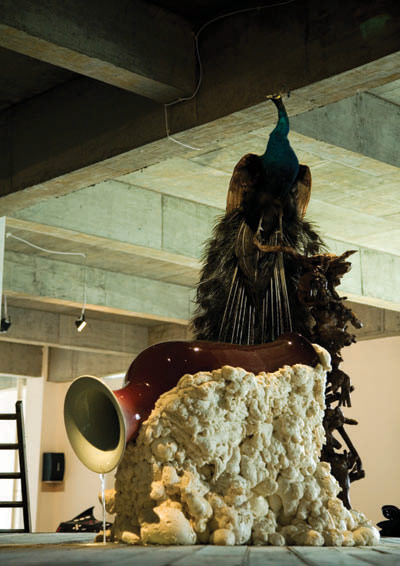
Zhang Ding produces intriguing art, which he then dismisses with a gentle smile as “having no meaning.” He does acknowledge that his work should induce a “strong feeling,” but never lets on exactly what sort. In China as elsewhere, artists often avoid explaining their works, affecting a simple nature in order to protect their ideas. Yet even against this background of a widespread refusal to narrate, Zhang Ding seems to go a step further, raising the hard question of what it means to do interpretive work, and particularly, how brazen the critic can be before venturing into speculation. His output to date, more notable for its consistency than its volume, leaves the would-be interlocutor in a bind: If he is simply making interesting objets d’art to amuse the public, Fabergé eggs for contemporary Czars, are we wrong to be disappointed? On the other hand, if we suspect there are weightier matters involved, then we must devote ourselves to their lonely excavation.
Born in 1980 in Zhangye, a small town in Gansu Province, he graduated in 2003 from Northwest Minorities University with a degree in painting and moved to Hangzhou to study at the China Academy of Art, becoming in effect an internal migrant. It was in Hangzhou that the artist began making films. In 2004, he moved to Shanghai, where he continues to live and work. Zhang Ding’s early films were documentary in form, focusing on marginal peoples—minorities, urban migrants, homosexuals, and the homeless. This soon developed into a more elaborate oeuvre of multi-media installations including quasi-theatrical sets, amplifiers, and multi-channel videos that, among other things, examined the relationship between the artwork and the space in which it was situated, and whether the viewer was a passive or active participant in that space.
His first major installation was Big City at BizArt in 2005, but his breakthrough exhibition really came in 2007 with “Tools” at Building-A in Shanghai’s M50 art district. There were two themes to that exhibition. First was a series of meditations on the metaphoric and physical qualities of the cactus, a plant full of contradictions, so sharp yet so delicate. A bed of cacti mounted in a concave formation on a large half-drum were methodically vivisected by huge scalpels. Another work involved a shower sprinkler system that watered a suspended cactus to death, the weight of the plant triggering the water flow—a type of crucifixion. Finally, a three-minute dual-channel video showed Zhang using cacti bunched together as a punching bag. It is extremely difficult to watch—the punches aren’t pulled, though Zhang took care to try to hit the same spot each time. The second half of the exhibition involved a mountain of old domestic refrigerators filled with amplifiers and a simple pull-push detonator running out to the viewer. When triggered, the amplifiers blasted out a deafening explosion. Both limbs of the exhibition meditated on circular systems, the snake that eats its own tail. Yet while there are numerous paths for one’s thoughts to meander in relation to this body of work, within the exhibition itself the viewer was left still unclear of the objective of Zhang’s artistic game.

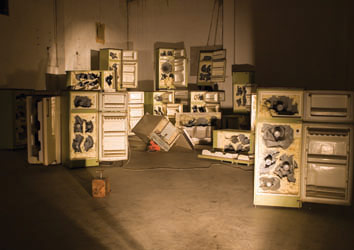
ssssssssssssssssssssssssssssssss
In 2008, Zhang Ding was invited to undertake a residency in Vienna courtesy of noted contemporary gallery Krinzinger Projekte. The result was the exhibition “Wind,” whose themes were revisited in last year’s solo-exhibition, “Law” at ShanghART’s Beijing space. Repetition and refinement is one of the markers of Zhang’s more recent practice. He works slowly and precisely, his practice constituting an ongoing reflection upon the path already walked. “Wind” presented a simple wooden ramp with two diving-plank wings. Beyond the ramp, large-scale Polaroid prints crowded into the end of the room, flung there as if by the exhibition’s eponymous “wind.” There, images of semi-submerged legs standing in a lake, a tree on a hill, and a blue sky with scattered clouds surrounded a real fir tree. The lighting was artificial and the gallery space was cramped, the atmosphere, despite those airy landscapes, claustrophobic. These are hybrid playground-theaters, spaces in the process of becoming dramatic. In viewing them, we enter the stage.
This point becomes clearer when we consider Zhang Ding’s film Great Era (2007), in which the artist revisited the theme of immigration. It is a poem to the dreams of rural immigrants and a paean to the Italian film director Federico Fellini. The film opens and closes with rich red curtains. A dapper man bicycles through the nighttime streets of Shanghai in a reverie, a horse head mounted on his handlebars. He then participates in an old-fashioned public dance and later eats at a simple stall. Suddenly he is naked in a grimy bathhouse, paddling fiercely in a shallow pool, the bicycle’s wheels flinging off water. Finally, we have the stage and its red curtains as a self-conscious nod to a viewing audience.
When asked about his influences, Zhang Ding cites Zhang Peili, Geng Jianyi, Alexander Brandt, and Liu Wei the Younger. I suggested to him that his mentors would appear to be film directors as well as artists, such luminaries as Fellini and Hitchcock. But Zhang corrects me, noting how the formerly cited artists precisely develop their ideas. So what Zhang takes away is not an aesthetic influence but rather a general methodology or working process. Still, this conclusion leads us no closer to the meaning of his practice.
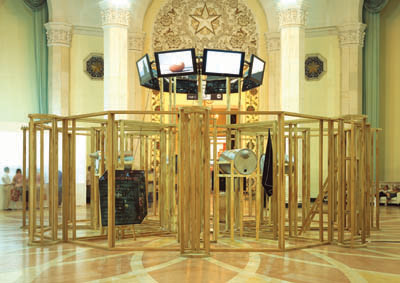
Zhang Ding’s next major project was The Dream of Yabulai, first shown at the ShContemporary Art Fair in 2009. The work involved a large hexagonal wooden frame with spokes connecting to a central axis, the whole structure surmounted with nine distinct videos. The central video shows a monkey assigning roles, Prospero-like, to eight actors, who then act out or embody their assigned roles, depicting key moments in humanity’s historical development, such discoveries as mapping, energy, art, religion and war. “Science” is represented by an egg being scrutinized under a magnifying glass. The scene becomes disconcerting only when we realize that the egg is slowly being cooked by its solar attention. The realization hits us like the explosion of Zhang’s refrigerators, the visceral punch to the cactus. The Dream of Yabulai was recently remade for James Cohan Gallery’s “The Tell-Tale Heart” exhibition in Shanghai. The new sitespecific version was dramatically scaled-down to about one quarter of its earlier size. The screens are also much smaller, personal in scale, and this time the monkey-god, playing the role of Brechtian-prologue, has his own separate explanation stand, just like in a real museum. The setup raises questions of where exactly the art begins.
Last year was Zhang Ding’s busiest to date. He participated in ShanghART’s “Blackboard” exhibition, where his miniature film installation was one of the standout pieces. It showed Zhang using a hammer to smash a blackboard covered with illuminated light bulbs, the crashing sound reverberating disproportionately throughout the exhibitions space. This was followed by his solo show “Law,” and a major piece in “Bourgeoisified Proletariat,” a pop-up exhibition on the outskirts of Shanghai during the ShContemporary art fair. “Law” was composed of two parts, one of which presented a diabolical machine recalling Charlie Chaplin’s iconic comedy of mechanization Modern Times. Yet “Law” was altogether darker. The purpose of Zhang’s machine is relentless self-harm; the contraption smashes blazing lightbulbs on a conveyor belt. Remember the cyclically destructive cacti pieces? The works’ logic is relentless and self-fulfilling. The second aspect of “Law” was a new iteration of “Wind.” This time the ramp brought the viewer to a specific view between fir trees in a Roman loggia, reminiscent of the extreme perspective achieved in the Borghese Garden in Florence. The shape of the stage recalled a sort of crucifix mounted by stairs, whereupon one was again confronted by a baleful choice: planks extending into nothingness on the left and the right, or, up a slight gradient, a raised diving platform. The gradient induced a sense of trepidation, and upon reaching the platform one gazed down into a hemisphere filled with more blazing light bulbs, inevitably inviting risk. To underscore the point, a bottle filled with water swung slowly above, a Foucault’s Pendulum threatening to fall, smashing the bulbs and causing everything to short-circuit. As viewers we are placed in the precarious position of angels almost able to achieve the perspective of God, so-called “Law,” but only by risking our own life: surely we will fall on the light bulbs too and be broken, sliced and electrified.
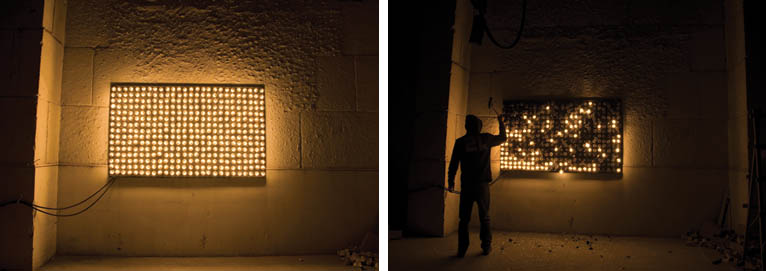
Striking a slightly different note was Zhang Ding’s installation A Game of Unclear Direction from “Bourgeoisified Proletariat.” That work comprised a wooden stage raised about a meter off the ground, lit from above and below. The piece involved a curious and confusing array of props: a ladder, a ramp, salt, a traditional Chinese garden, a peacock, carpet, and a boat set into the stage itself. Again the viewer was able to climb onto the stage, but no prompt was given as to what to do with the props. As if in a dream of being naked and exposed in a public place, the viewer was simply left helpless.
What all of these works have in common is a preoccupation with the condition of observation and participation. The “strong atmosphere” Zhang Ding invokes is a mere ploy, priming us for the experiment. What we are required to answer, from the disturbing cynosure of a public stage, is who is acting. The unwitting player is not immediately aware they have entered another world, slipping from omniscience into a dream. The purpose of the shock, whether the cactus punches or sense of exposure, is to allow Zhang to sing us, like Ariel, Awake! Awake! Out of our idyll we are torn, the shock delivering us back to reality, if not omniscience (that was only ever a delusion anyway). This is not, however, a play on Plato’s poor prisoners. We know all about that. The intention, so lightly made, is to disrupt a stable conception of reality by throwing us into another conception of it, whether the personal perspective of another viewer, a homeless entertainer, the physical one of “Law” and “Tools,” or the theatrical one of Great Era, Yabulai and Game. This was of course also Beuys’ approach—to disrupt the complacency of post-war Germany, of the middleclass, of conservatism in general, and to confront the viewer with their complacency.
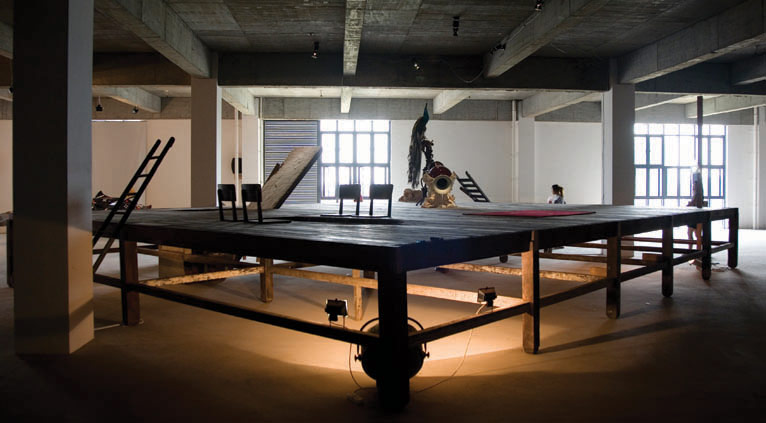
Ultimately Zhang Ding’s work may be seen as a series of deconstructed mise-en-scenes. The scenic displacement creates a psychic displacement whereby we are confronted with our imperfect vision, our “fallible omniscience.” The art is not in Zhang Ding’s props but in the moment of realization, euphoria mixed with horror. We have slipped onto the stage by accident and like Hansel and Gretel in the wood, cannot find our way back, not without first confronting our witch, that is, our own alternative reflection.


